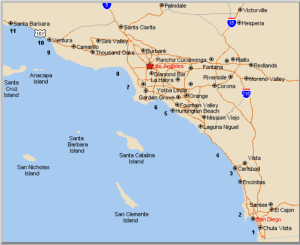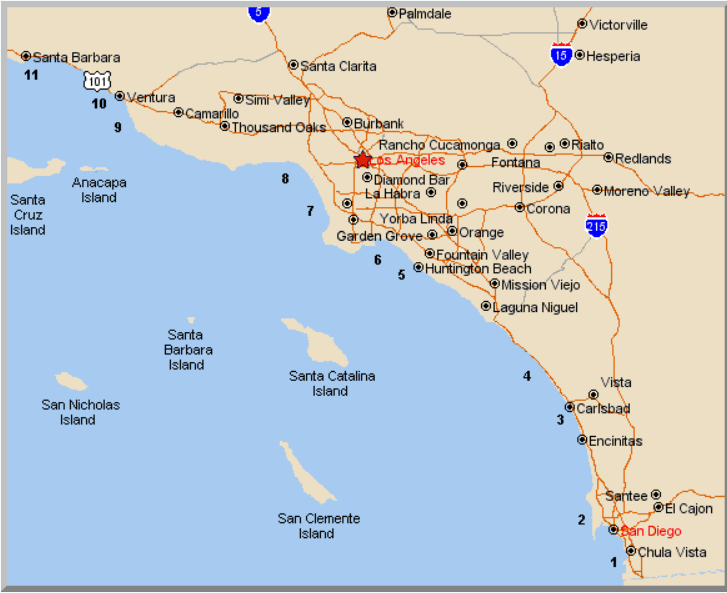Contents
Sand and Mud Flats Fishing
Sand and mud flats fishing refers to the many near coastal areas of Southern California sea bottom that is covered with sand or mud. This habitat has its own separate species of fish. Given some structure, such as an outcropping of rocks, an artificial reef, or a shipwreck, and the bottom fairly teems with game fish. Other species prefer the wide open spaces to wait to ambush passing prey. In all, these areas are probably some of the more popular, as well as productive areas to fish.
Map of California Sand and Mud Flats Fishing Areas

Map of California Sand and Mud Flats Fishing Areas
GPS Coordinates for California Sand and Mud Flats Fishing Areas
The following table shows the approximate center of the main flats fishing spots. Many of these cover wide expanses of ocean floor, and often the best fishing areas may be entirely different from one day to the next. This means that some trial and error may be needed to find a productive spot on any given day. Flats fishing is probably the easiest type of fishing along the Southern California coast.
| No. | Name | Area | Coordinates |
| 1 | Imperial Flats | Imperial Beach | 32D 36.30’N. x 117D 14.15W |
| 2 | Mission Flats | Mission Beach | 32D 46.00’N. x 117D 16.50’W |
| 3 | Powerplant | Carlsbad | 33D 02.20’N. x 117D 18.40’W |
| 4 | Clam Beds | Camp Pendelton | 33D 14.30’N. x 117D 27.30’W |
| 5 | Huntington Flats | Huntington Beach | 33D 39.30’N. x 118D 03.40’W |
| 6 | LA Harbor Area | Long Beach | 33D 38.80’N. x 118D 13.20’W |
| 7 | Scattergood Flats | El Segundo | 33D 55.20’N. x 118D 26.50’W |
| 8 | Santa Monica Bay | Santa Monica | 34D 01.00’N. x 118D 32.00’W |
| 9 | Hueneme Flats | Port Hueneme | 34D 08.32’N. x 119D 12.95’W |
| 10 | Ventura Flats | Ventura | 33D 40.07’N. x 118D 12.15’W |
| 11 | Santa Barbara Flats | Santa Barbara | 34D 14.00’N. x 119D 19.00’W |
| IMPORTANT NOTE! The GPS coordinates indicated here are for informational purposes only. They represent the author’s belief of the correct approximate locations of various fishing areas. These numbers should NOT be used for navigation. No guarantee of the accuracy of this information is expressed nor implied. ALWAYS use proper navigation methods and techniques when operating a boat anywhere in coastal or offshore conditions. | |||
Best Times of Year for California Sand and Mud Flats Fishing
Following is a chart of the commonly caught flats fish, the time of year you’re likely to catch them, and the preferred depths. Be SURE to check with the California Department of Fish and Game for the latest regulations on closed seasons, closed areas, minimum size and maximum bag limits on any fish you plan to take. The regulations change often. This information is available on-line on the Cal DF&G; website at: http://www.dfg.ca.gov/
| Fish | Best Fishing | Possible | Depth | Best Bait |
| Halibut | Nov-Apr | Year Round | Bottom | Live Bait |
| Sand Bass | Mar-Aug | Year Round | Bottom | Live Bait |
| Sculpin | Nov-Jun | Year Round | Bottom | Cut Squid |
| Barracuda | Jun-Sep | Mar-Nov | Surface to Midwater | Lures |
| Sand Dabs | Year Round | Year Round | Deep Sand | Cut Squid |
| White Croaker | Mar-Sep | Year Round | Bottom | Cut Squid |
| Starry Flounder | Feb-Aug | Year Round | Shallow Bottom | Cut Squid |
How To Fish California Sand and Mud Flats
There are two general ways to fish the flats. The first is to anchor up in a “fishy” area, either a productive spot, or one where you’re metering activity on a bottom meter, and send down bait to the bottom. The second is to allow the boat to drift with baits bouncing along the bottom as the boat moves. The first, anchored, method is most productive when Sand Bass or Sculpin spawns are underway and the fish are congregated in a fairly small area. It also works well when anchoring near submerged structure like a reef or wreck. If you aren’t sure where the hot spots are, the second, drifting, method seems to work better. Halibut in particular are more suseptable to the drifting method since they often wait in ambush for a meal to come drifting by. You could literally be inches from a Halibut’s tail with your bait if anchored, and the fish would never see the bait.
The preferred rig in shallower areas is the Carolina rig, that is, a 3/4 to 1-1/2 oz sliding egg sinker held 24-36″ above the bait hook with a split shot, swivel, or “Carolina Keeper” plastic bead. In deeper water, a reverse dropper loop is often the hot ticket. Attach a 2-4 oz torpedo sinker on a dropper loop 24-36″ above the bait hook, and send her down baited with a live bait or piece of cut squid. If using live bait, keep changing the bait so it’s lively for best results. Also nose hooking a bait is usually better than gill hooking when fishing the flats. the bait swim more naturally and seem to survive better.
Artificial lures are also useful in the flats. When Sand Bass and Barracuda are around, a hard metal jig, allowed to sink then yoyo’ed up and down makes an enticing target. In addition, rubber swim baits fished bare, or baited with a thin strip of cut squid can really knock the Sand Bass and Halibut dead when other techniques aren’t working.
Conclusion
Hopefully, you will find this article helpful in providing information about treating and maintaining your fishing line and reel. Simply leave a comment below the article if you have any queries, and we’ll get back to you as soon as possible. Please spread the word and help us as we publish more fascinating forum posts if this is your favorite.


